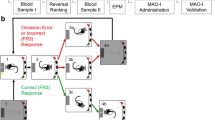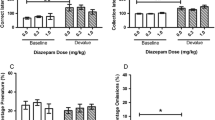Abstract
Previously, several studies in our laboratories have linked the ability to initiate movement rapidly (reactive capacity) in several rat strains to markers of nigrostriatal dopamine function. In the present investigation we wished to determine the extent to which fast-reacting (FR) and slow-reacting (SR) rats responded differentially to the effects of dopamine agonist (apomorphine) administration. Fisher 344 rats were operantly conditioned on a shock-avoidance, reactive capacity task which requires extremely fast, ballistic, lever release responses. In FR, but not in SR rats, significant dose-dependent decreases in the per cent of successful avoidance trials were observed in response to apomorphine doses. Moreover, apomorphine brought responding in the FR animals to levels below that of the SR rats. Performance of the SR rats was unaffected by drug treatments. A number of interpretations are consistent with these preliminary data, including the idea that basal differences in speed of reaction and differential responses to a dopamine agonist, antiparkinsonian agent may both be associated with a similar mechanism; differential activation of compartmentalized striatal efferent systems.
Similar content being viewed by others
References
Alexander GE, DeLong MR, Strick PL (1986) Parallel organization of functionally segregated circuits linking basal ganglia and cortex. Annu Rev Neurosci 9:357–383
Amalric M, Conde H, Dormont JF, Farin D, Schmied A (1984) Activity of caudate nucleus neurons in cat performing a reaction time task. Neurosci Lett 49:253–258
Bannon MJ, Roth RH (1983) Pharmacology of mesocortical dopamine neurons. Pharmacol Rev 35:53–68
Beckstead RM, Cruz CJ (1986) Striatal axons to the globus pallidus, entopeduncular nucleus, and substantia nigra come mainly from separate cell populations in cat. Neuroscience 19:147–158
Creese I, Sibley DR, Hamblin MW, Leff SE (1983) The classification of dopamine receptors: relationship to radioligand binding. Annu Rev Neurosci 6:43–71
Feger J, Crossman AR (1984) Identification of different subpopulations of neostriatal neurons projecting to globus pallidus or substantia nigra in the monkey: a retrograde fluorescence double-labeling study. Neurosci Lett 49:7–12
Heim C, Schwarz M, Klockgether T, Jaspers R, Cools AR, Sontag K-H (1986) GABAergic neurotransmission within the reticular part of the substantia nigra (SNR): role for switching motor patterns and performance of movements. Exp Brain Res 63:375–381
Herkenheim M, Pert C (1981) Mosaic distribution of opiate receptors, parafascicular projections and acetylcholinesterase in rat striatum. Nature 291:415–417
Loopuijt LD, van der Kooy D (1985) Organization of the striatum: collateralization of its efferent axons. Brain Res 348:86–99
Mandel RJ, Randall PK (1985) Quantification of lesion-induced dopaminergic supersensitivity using the rotational model in the mouse. Brain Res 330:358–363
Matthews RT, German DC (1986) Evidence for a functional role of dopamine type-1 (D-1) receptors in the substantia nigra of rats. Eur J Pharmacol 120:87–93
Mattingly BA (1986) The effects of apomorphine on leverpress shock escape learning in rats. Pharmacol Biochem Behav 25:693–695
Pan HS, Penney JB, Young AB (1985) Gamma-aminobutyric acid and benzodiazepine receptor changes induced by unilateral 6-hydroxydopamine lesions of the medial forebrain bundle. J Neurochem 45:1396–1404
Scheel-Krüger J (1986) Dopamine-GABA interactions: evidence that GABA transmits, modulates and mediates dopaminergic functions in the basal ganglia and limbic system. Acta Neurol Scand [Suppl 107] 73:9–49
Smith RV, Stewart JT (1981) Textbook of biopharmaceutic analysis. Lea and Febiger, Philadelphia, pp 84–85
Smith Y, Parent A, Sequela P, Descarries L (1988) Distribution of GABA-immunoreactive neurons in the basal ganglia of the squirrel monkey (Saimiri sciureus). J Comp Neurol (in press)
Speciale SG, Miller JD, McMillen BA, German DC (1986) Activation of specific central dopamine pathways: locomotion and footshock. Brain Res Bull 16:33–38
Spirduso WW, Farrar RP (1981) Effects of aerobic training on reactive capacity: an animal model. J Gerontol 36:654–662
Spirduso WW, Abraham LD, Wolf MD (1981) Effects of chlorpromazine on escape and avoidance responses: a closer look. Pharmacol Biochem Behav 14:438–443
Spirduso WW, Gilliam PE, Wilcox RE (1984) Speed of movement initiation predicts differences in 3H-spiroperidol receptor binding in rats. Psychopharmacology 83:205–209
Spirduso WW, Gilliam PE, Schallert TJ, Upchurch M, Vaughn DM, Wilcox RE (1985) Reactive capacity: a sensitive behavioral marker of movement initiation and nigrostriatal dopamine function. Brain Res 335:45–54
Walters JR, Bergstrom DA, Carlson JH, Chase TN, Braun AR (1987) D1 dopamine receptor activation required for postsynaptic expression of D2 agonist effects. Science 236:719–722
Wilcox RE, Hightower WH, Smith RV (1979) Post-hoc data analysis in biomedical research. Am Lab II:32–45
Wilcox RE, Mudie E, Mayfield D, Young R, Spirduso W (1988) Movement initiation characteristics in young adult rats in relation to the high- and low-affinity states of the striatal D2 dopamine receptor. Brain Res (in press)
Winer BJ (1971) Statistical principles in experimental design. McGraw-Hill, New York, pp 685–752
Wolf MD, Wilcox RE, Riffee WH, Abraham LD (1980) Strain differences in dopamine receptor function and the initiation of movement. Pharmacol Biochem Behav 13:5–7
Author information
Authors and Affiliations
Rights and permissions
About this article
Cite this article
Wilcox, R.E., Spirduso, W.W. Apomorphine doses impair the reaction time of fast reacting but not slow reacting rats. Psychopharmacology 95, 276–279 (1988). https://doi.org/10.1007/BF00174524
Received:
Revised:
Issue Date:
DOI: https://doi.org/10.1007/BF00174524




